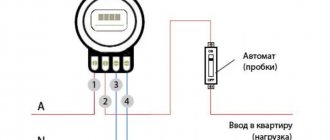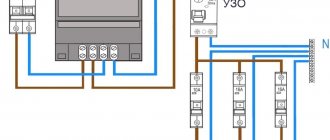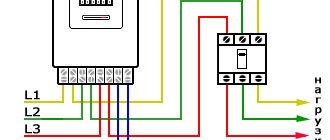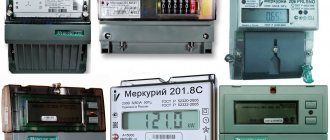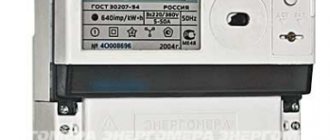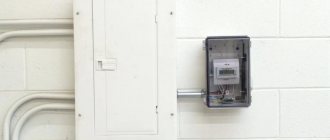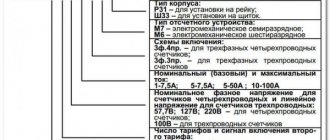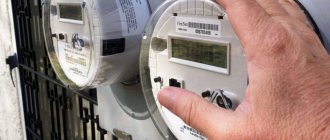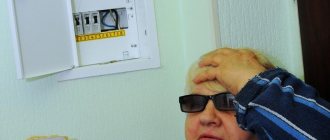When summer residents will have to move the electric meter to a street pole: a new point in the rules
Current update.
The first such requirements began to appear more than 5 years ago, but still not all owners of dachas and private houses know how to respond to them. Has the problem affected you too? This means it’s time to study the legislative framework. It is important to remember that this issue has quite significant nuances. For example, the legality of the requirement depends on whether your property is an individual housing construction or a country house, has been built and operated for a long time or is just under construction, is located in Russia or Belarus, etc.
Moving meters outside in dacha cooperatives and gardening associations
You can often hear that the chairman of SNT began to demand that electricity meters be moved from houses to the street, citing the fact that this way it is possible to control electricity consumption and fight theft. However, out of the blue the chairman has no right to make such demands. According to the Federal Law of April 15, 1998 No. 66-FZ, as amended. dated 07/03/2016 “On gardening, gardening and dacha non-profit associations of citizens”, all decisions of this kind are made only by the general meeting. That is, this topic must be put on the agenda in advance, discussed and voted on. If this does not happen, you can safely ignore the requirements. If your neighbors, for the most part, agreed to the demands, you will also have to comply.
Moving meters outside in private homes
In private households, no one orders you at all. Decide for yourself whether you agree or disagree with the requirements of the energy supply organization. However, remember that the law is on your side, and if representatives of Energosbyt or a similar organization begin to insist, demand that they voice the legislative standards that guide them. According to the current Electrical Installation Rules (PUE) clause 1.6. 6 and 1.5.27, which, by the way, are advisory and not mandatory, the electric meter should be located at the boundary of the network (according to the balance), as well as in dry, easily accessible rooms, a place not cramped for work, where the temperature in winter is does not fall below 0°C. Otherwise, it is not indicated in the Decree of the Government of the Russian Federation dated 05/06/2011 No. 354 “On the provision of utility services to owners and users of premises in apartment buildings and residential buildings”, which came into force on September 1, 2012. In addition, the requirement to install a meter on the street also violates Art. 210 of the Civil Code of the Russian Federation, since you, while remaining the owner of the meter, will not be able to fully maintain it. What do these standards, articles and acts mean when translated from legal language into human language? To begin with, this requirement is not regulated by any legislative act or regulation. That is, this is solely the wish of the company with which you have a contract for the supply of electricity. And you have every right to refuse this wish. Now let’s look in more detail at why this is beneficial to representatives of Energosbyt and not beneficial to you. Yes, on the one hand, their specialists will really be able to control the operation of the meter and take data without prior agreement with you, which will save them a lot of effort and time. On the other hand, if you regularly visit the house, then it will not be difficult for the inspectors to contact you. At the same time, meters placed outside are quite often broken by vandals, stolen in whole or in parts, they overheat in the sun, they are flooded with rain, and this inevitably reduces their shelf life. In addition, when temperature changes occur, many of them give incorrect readings or stop working altogether. And the owner, that is, you, will have to pay for the repair, replacement or restoration of a broken meter. As you can see, there are not many reasons to change the “place of residence” of the electric meter, and even those that exist are very doubtful. Remember that your refusal is legal and they have no right to turn off your electricity if all your bills are paid on time. If such threats begin to come from representatives of Energosbyt or other organizations, you have the right to go to court. For residents of the Republic of Belarus, the situation is fundamentally different - on October 17, 2011, the Council of Ministers adopted resolution No. 1394 on the need to remove electricity meters from residential premises and install them outside the house on the territory of the site.
Our advantages
Our specialists have extensive experience and professional skills in the field of electrical installation work.
In addition to installing the meter itself, we offer installation of a power limiter, an input circuit breaker, an RCD, and an electrical panel. We carry out the work promptly and efficiently, and provide a 12-month guarantee. The cost of installing an electric meter on a pole depends on several conditions:
- location height;
- meter configuration and type;
- support material;
- fastening method;
- Availability of additional services (laying cables in pipes, activating machines, installing an electrical panel, etc.)
Cost of work
| Name of service | Price |
| Installation of a 15 kW pipe stand | 17900 rub. |
| Removal of an electric meter up to 7 kW to poles | 11200 rub. |
| Removing the electric meter to a 5 meter pipe stand 5 kW | 15900 rub. |
| Installation of a pipe stand 6 meters at 15 kW | 18900 rub. |
| Installation of a pipe stand 7 meters at 15 kW | 23900 rub. |
| Increase in power up to 15 kW | from 6000 rub. |
Electronic counter with remote control
When all apartments had induction electric meters, craftsmen invented various ways to change their readings downwards. With the advent of electronic analogs, this became almost impossible.
But on the Internet you can find a large number of offers for the sale of modified meters with remote control. The basic principle of operation of such a meter is that the electricity consumer can independently turn it on and off. At the same time, electricity enters the house, but remains unaccounted for. With such a remote control you can stop the counter completely or slow it down.
Almost any electronic meter can be modified and equipped with a remote control, but in this case the device case is opened, which means the factory seal and sticker with a digital code are broken. Sellers of meters with remote control claim that they are able to restore all this. New seals and stickers do not differ from the factory ones, and a visual check of the meter body before its installation is not able to detect these changes.
Such proposals are especially appealing to those who have moved their electric meter outside. With such a remote control, you can influence its operation. There is an opinion that it is better to place the device outside and stop it as needed from home.
Interfering with the operation of metering devices is illegal. If uncontrolled use of electricity is detected, the supplier company may impose a large fine on the consumer. Therefore, before purchasing meters with remote control, you need to think carefully about everything.
Reasons to move the device
The main factors for changing the location of the meter and related equipment in an apartment building are:
- obstacle in redevelopment;
- installation of new furniture;
- increased safety.
Moving the counter to the landing will allow you to perform the desired finishing or placement of decorative items. You can also place the device in a hidden way without changing the location. It will not be difficult to complete the task by choosing a very compact electronic meter. In this case, technical requirements will not be violated.
If the counter is initially located in the hallway of the apartment, then new furniture may be the reason for its movement. For example, a wall in a hallway. The meter and traffic jams are a significant obstacle that can easily be moved.
This will be a more profitable option from a financial point of view than custom fitting furniture. Very often, the placement point of the device is located in such a place that it is simply impossible to pick up or adjust the furniture.
This solution involves appropriate equipment with a protective box that will limit access to electrical equipment by unauthorized persons.
In this case, the readings should be easy to read by the controller.
If the wall is load-bearing and made of reinforced concrete, then hiding the device will be problematic and expensive. Therefore, most often they resort to choosing a different location for the meter.
Read more: Documents for changing a passport after expiration
Regular outages due to theft of circuit breakers or simply a power outage can become a reason to move the device from the entrance to the corridor of a privatized apartment. In this case, it is necessary to provide for placement in advance so that even rearranging the furniture does not become a problem.
Another advantage is the guaranteed absence of mechanical damage.
The modern model takes up minimal space and a plastic shield with an ergonomic design is suitable.
If the meter in the entrance is induction, from the last century, then it is better to replace it. At the same time, sometimes apartment owners even leave this one. The motivation is simple – cost reduction.
They only resort to replacing plug-type switches with more modern automatic ones. They are also transferred to the corridor of the apartment. This prevents unauthorized persons from gaining access to them. On the other hand, this approach cannot be considered a complete solution.
Methods for detecting electricity theft
Of course, as soon as it seems to you that your electricity bill is too high, you should not immediately accuse your neighbors of theft, since the reason for the incredibly high costs may not be the theft of electricity at all. Therefore, in order not to quarrel with the residents of your entrance, you should first understand the current situation in detail.
The most obvious signs that your electricity is being stolen are:
The presence of third-party wires at your meter - the connection of the electric meter has an established circuit, and the number of wires supplied to it is determined by the specified circuit of the manufacturer. An example of such a connection is shown in the figure below:
Electric meter connection diagram If, when examining your meter, you identify any third-party wires that fit in addition to the normal circuit, then this indicates that your neighbors are stealing electricity, taking it away from your meter. The direction of these additional conductors should then be found.
Presence of load in the electrical network when electrical appliances are turned off. The problem with many houses with old wiring is that there are adjacent sockets, when neighbors can easily connect to the terminals of someone else's socket. If you disconnect the load from the sockets located on such walls adjacent to neighbors and check the load in the line approaching it, then the presence of electric current will indicate that the neighbors are stealing electricity.
Checking the current load This method of theft is quite difficult to track down, unless you deliberately set such a goal, it can also be realized from distribution boxes, but this happens much less often.
The presence of potential on heating radiators, taps or other structures that have a common ground. Such a problem actually does not in any way affect the readings of your meter, electricity thieves simply bypass their own electricity metering and you are in no way in danger of losing electricity. But you face the threat of electric shock from touching batteries or taps, so it’s also worth fighting against such manifestations.
Wire tampering is popular in the private sector, but it will be easy to see if someone has illegally tapped into your line.
Therefore, for those living in the private sector, it is important to be especially vigilant in order to protect themselves from cunning neighbors.
Throw on the line
Inflating meter readings when all devices and loads in the network are turned off. If you have turned off everything that consumed electrical energy, and your meter continues to show electricity consumption, the fact of theft is obvious. This method of theft can be carried out by particularly experienced attackers who know how to hide connection points well, so you need to turn to highly qualified specialists for help.
To combat the above methods, no measures in the form of automatic electricity metering systems or meters with magnetic seals will help, since power will be taken directly from your line.
Which electricity meter is best to install in an apartment?
The topic of today's article: which meter to install in an apartment. Formally, this should be handled by the company that sells electricity, but in practice it turns out that this is a problem for buyers of this very electricity. As in the famous aphorism of Ilf and Petrov about drowning people and the work of helping them. Apartment residents are required to have an electricity meter and replace it if it is outdated and does not meet modern requirements. This is where it turns out that choosing the right counter is not an easy task. There are so many offers that you can get confused. Choosing exactly what you need from hundreds of possible options seems completely unrealistic. Let's try to understand this ocean of metering devices, which electricity meter is better to install in an apartment or private house..
Unlike induction, electronic devices are multifunctional and can be designed for several tariffs. They are more compact in size, which means they take up less space on the input panel. Their cost is higher, and in terms of working life they are inferior to induction ones.
Interesting: How to change your driver's license when changing your last name
Refusal to place the meter outdoors
Owners of private houses can provide the service company with access to the meter on the premises. In such a case, installation on the street does not make sense.
If the electricians insist otherwise, the owner can specify an installation location different from the one proposed. Compliance with the PUEs that are emphasized is mandatory. Installation of an electricity meter is permitted only with the written consent of the owner of the site. Two documents must be signed: consent to installation and the act of determining the installation location. To verify legality, the presence of a disinterested legal entity is desirable.
The electricity supplier does not have the right to violate or force an individual to violate the law. If any illegal actions occur, you should contact the prosecutor's office.
https://youtube.com/watch?v=G_209-2YWhw
Replacing an electric meter in a private house
At the end of the norm establishing this rule, there is a clause that a different procedure may be established by laws or other regulations. And since the reasons for the breakdown are different, and the answer to the question of at whose expense the electric meter in a private house should be replaced depends on them, then the obligation to finance this procedure does not always arise with the above-mentioned organization. For example, if the meter is damaged due to the fault of the owner (broken, stolen, burned), then he must pay for its replacement.
The rights and obligations of persons when replacing electricity meters in private homes are provided for by the Civil Code of the Russian Federation and other legal acts. As a general rule, when the subscriber under the contract is a person who uses electricity for domestic consumption, ensuring the proper technical condition of energy metering devices is the responsibility of the energy supply organization.
We recommend reading: Application for Income Tax Reimbursement Form 2020 Sample Filling Out
Rules for choosing a machine
The machines are selected taking into account the load parameters and characteristics of the wire. The main indicators of the circuit breaker are displayed on the front of the case in the form of markings.
Deciphering inscriptions on the machine
Depending on the voltage value and the number of poles, the following types of products are produced:
- single-pole - 220 V (for one phase wire);
- bipolar - with a similar voltage value (for 2 wires - phase and neutral);
- three-pole - 380 V (for three phase wires);
- four-pole - the same voltage (with three phase and one neutral wire).
When choosing a machine, you need to take into account the characteristics of the network and the number of wires involved. If the installed devices constantly work for no apparent reason, it makes sense to select products of higher power and install them to replace the ones in use.
We recommend: Reasons why the electricity meter may be buzzing
The device is selected based on the wire cross-section, current and power characteristics indicated in the table:
The operation of the electrical network is organized in such a way that the weak link is played by a circuit breaker that turns off when the indicators are less than critical. The devices are formed into groups, depending on the categories of consumers according to power characteristics, with the corresponding selection of device power.
One of the characteristics of the machine is time-current, the essence of which is determined by the formula:
K = I/In
wherein:
- K – multiplicity value;
- In – rated current;
- I – value of current in the network.
The following categories of multiplicity are distinguished, depending on the value of K:
- B – from 3 to 5;
- C – from 5 to 10;
- D – from 10 to 20.
As the magnification increases, the response speed of the device increases.
In addition to the multiplicity, the response speed varies depending on the ambient temperature. As it increases, a smaller current value will be required to turn off the machine.
There are 3 classes of current limitation, indicating the operating time of the device:
- third – up to 3 ms;
- second – 5 – 6 ms;
- the first is about 10 ms.
As the class increases, the cost increases and the quality of the device improves. Most household products are manufactured in the third class.
Each element is made in the form of a separate module mounted on a DIN rail. The width of one module is 17.5 mm.
Is it possible to bypass
The theft of electricity causes damage to both the citizen and the state. Lovers of “freebies” hack into panels, install gadgets to stop the count, and are included in the circuit without permission. Attempts to cheat the meter lead to fires, power surges, and damage to household appliances.
The government has introduced amendments to the Code of Administrative Offenses of the Russian Federation. From 2022, a triple fine will be issued for repeated illegal tappings. For the first violation you will have to pay 10-15 thousand rubles. For a repeat – from 15 to 30 thousand rubles. A relapse is fraught with removal from office for 2-3 years. For legal entities the measures are stricter. Failure to pay fines may result in exclusion, a ban on traveling abroad, seizure of property, or court action.
The authorities hope that innovations will stop the mass outrages in the electricity sector.
Thanks to smart mechanisms, conscientious subscribers will not have to pay the bills of offenders. Responsibility will fall on the debtors. New models will help resolve disputes between suppliers and consumers. Useful article? Rate and share with friends!
What do you need to connect?
First, you will need to decide on the location where the introductory electrical panel will be installed. If we are talking about a country cottage, then it is determined on the street, for this a wall cabinet will be used. However, most often it is mounted inside the apartment in order to ensure the safety of the equipment from strangers. The best choice would be a corridor closer to the front door. This location will save on the length of the power cable.
According to the standards, it must be installed on a flat surface about 1.5 m from the floor, away from pipelines, water and gas.
When connecting the electrical panel, you need to follow the following algorithm:
- prepare the wires;
- install a box;
- secure DIN rails;
- arrangement of modular devices and terminal blocks;
- switching is the process of connecting wires to modular devices. To complete this stage, first strip the conic wires and, if necessary, put lugs on them. Then they are inserted into the terminals of the machines and screwed tightly;
- connect the input cable, neutral phase and grounding;
- carrying out test switching on of machines. In this case, you need to wear rubber gloves and stand on a rubber mat.
Removal of metering devices to SNT
SNT members are also concerned about the installation of electricity meters outside the home.
In his demands, the chairman is trying to reduce the theft of electricity by moving the meter from the house to the street. But members of society do not want to do this. Because the majority live in SNT only in the warm season. The rest of the time no one guarantees the safety of the equipment. If the meter is removed from a country house, it may be stolen in winter.
Therefore, the question arises whether this demand of the chairman is legal. Lawyers say unequivocally that such a requirement is illegal. But if the general meeting made a resolution and more than 50% of the members voted, then such a requirement is justified. And it will have to be done.
Types and types of devices
Electric energy meters are divided into types and types according to different criteria. Among them: design, number of phases and tariffs.
Induction and electronic
Induction meters are familiar to everyone. Previously, they were everywhere; this type of device was developed a long time ago. It looks like a disk drive. Electricity passes through such a counter, a magnetic field is formed, and because of this, the disk produces revolutions. Each rotation of the disk is equal to a certain amount of electricity consumed. The main advantage of such a device is its reliability - they can work properly for up to thirty years! But there is also a big drawback: the measurement error is very high.
Electronic meters have appeared quite recently. They measure electricity consumption directly and can store or transmit data. Such devices are many times more accurate than induction devices and take into account the minimum load.
Single-tariff and multi-tariff
An induction meter can only operate on one tariff. But when purchasing an electronic meter, you can choose a multi-tariff device. In this case, the recorder will count electricity depending on the time: at a day or night tariff.
This is convenient because the cost of electricity varies during the day and at night. Therefore, a consumer with a two-tariff meter can turn on the heater at night and pay less for electricity.
By number of phases - single-phase and three-phase
The electric meter can be suitable for single-phase 220 V or three-phase 380 V networks. Before purchasing, be sure to check which network is used in your home.
Leading manufacturers, popular meter models and analysis of their prices
Metering devices, regardless of water or electricity, are installed for more than one year, so you need to purchase only high-quality and reliable equipment. It is best to buy devices only from trusted manufacturers, such as:
- Inotex;
- Energy meter;
- Typeit.
The use of multi-tariff meters provides great benefits.
The Inotex company is a well-known Russian brand with a 15-year history. It produces electronic electricity meters, which occupy a leading position in sales in the Russian Federation.
Energomera is the largest manufacturer of electricity metering devices. The company entered the electrical appliances market in 2010.
Taypit is a company from St. Petersburg, founded in 1999. The company is engaged in the production of measuring equipment, including electricity meters.
| Manufacturer | Model | Average cost, rub. |
| Neva 103 1SO/ Taypit |
| 680−760 |
| Manufacturer | Model | Average cost, rub. |
| Mercury 201.8/ Inotex |
| 580−740 |
| Manufacturer | Model | Average cost, rub. |
| CE102M S7 145-JV/ Energy meter |
| 1 400−2 075 |
| Manufacturer | Model | Average cost, rub. |
| Mercury 200.02/ Inotex |
| 1 500−1 800 |
| Manufacturer | Model | Average cost, rub. |
| Mercury 231 AM-01/Inotex |
| 2 040−2 420 |
| Manufacturer | Model | Average cost, rub. |
| CE300 R31 043-J/Energy meter |
| 2 120−4 400 |
| Manufacturer | Model | Average cost, rub. |
| Mercury 231 AT-01/Inotex |
| 2 790−3 220 |
Judging from the information above, electricity meters with automatic transmission of readings are suitable for:
- Neva 103 1SO – for ordinary apartments;
- Mercury 200.02 – for municipal premises;
- Energy meter CE300 R31 043-J – for a small residential building;
- Mercury 231 AT-01 is the best option for a large cottage.
It is best to install multi-tariff electricity meters. They allow you to more effectively plan your electricity consumption and payment.
Watch this video on YouTube
Remote meter design
The operating principle of new electricity meters with remote data collection is based on converting analog signals into pulses, on the basis of which the amount of energy consumed is calculated. The main difference between electronic devices and induction devices is the absence of driven mechanical parts and wider functionality:
- A well-organized electricity consumption metering system.
- Increased input voltage interval.
- Saving and providing data for previous accounting periods.
- Connection to systems for collecting and sending information to the supplier.
- Power consumption measurement.
The design of a remote electricity meter is represented by the required details:
- Liquid crystal display.
- Timer with actual time display.
- Transformer.
- Connectors for connecting telemetry.
- Control and monitoring elements.
- Supervisor.
- Power supply.
- An optical port can be installed optionally.
The liquid crystal display of the electric meter with remote readings displays information about the amount of energy consumed, the actual date and time, the operating mode of the device and the tariff.
An independent power source ensures the operation of the meter's electronic circuit. A supervisor is connected to it, which creates a reset signal for the microcontroller, which occurs when the electric meter is turned on or off remotely. With the help of the supervisor, changes in the input voltage are monitored.
The clock function in some models is performed by a microcontroller. The part is equipped with a separate microcircuit that reduces the load and power consumption, which allows you to redirect energy to solve other problems.
You can connect an electric meter with a remote control to a personal computer or data transmission system using a telemetry output. Information is collected from the metering device via the optical port.
Metal cabinet for electric meter
As a protective measure, if an electronic electric meter was installed on a pole, a special metal box is installed for it. Such a box is installed before installing the meter and has a special viewing window (for unhindered readings).
The metal box performs several functions at once, namely:
- Protection against vandalism and theft. In order for the box to perform this function, it is securely fixed to a pole and equipped with a locking mechanism;
- Protection from moisture, which allows you to significantly increase the operational period of the electricity meter;
- Protection against hypothermia. If the ambient temperature drops below zero, the meter may begin to work incorrectly. The measurement error can be significant, which will affect the amounts of payments for electricity supplied to the consumer. It follows from this that good thermal insulation of the electric meter cabinet is a measure aimed at ensuring the correct operation of the meter.
The wires from the electric meter are hidden in a special protective metal pipe. It is advisable to leave the distribution panel with circuit breakers in the house, and place one circuit breaker on a pole.
In conclusion, it should be noted that installing and connecting an electric meter is not a very complicated procedure, however, without experience in carrying out such work, you should not perform it yourself.
It is better to contact specialists, since the power supply of the entire house, as well as the operation of all electrical appliances in it, depends on how correctly the meter is installed. In addition, we should not forget about our own safety when installing an electric meter on a street pole.
In addition to the above, we suggest that you familiarize yourself with the video instructions, which will help in assembling the control panel for installing an electric meter on the street on a pole.
Requirements for installing an electric meter
In order for the new electric meter to work correctly and without breakdowns throughout its entire service life after replacement, it is necessary to properly prepare the place for its installation. The operating life of the device and its accuracy are influenced by the following factors: humidity, temperature and composition of the surrounding air, vibration.
Basic installation requirements:
- if the installation is carried out indoors, then it should be dry, if outdoors, then a special sealed box should be installed;
- when choosing a location, it is necessary to take into account that it is convenient for servicing and checking the device;
- installation is carried out on a rigid surface that should not vibrate, deform or move;
- can be installed on metal, plastic or wooden panels;
- the surface must be vertical;
- the device can be located within 80-170 cm from the floor, it is best for it to be at eye level;
- the meter cannot deviate from the vertical by more than 1 degree, otherwise there will be a large error in its readings. This requirement is relevant for induction models; electronic devices are less sensitive in this regard;
- the connected wires are well stripped to a minimum of 1.2-2 cm;
- be sure to do grounding;
- mandatory presence of circuit breakers that, if necessary, allow you to turn off this device.
No tags for this post.
Purpose
Remote transmission of electricity meter readings is carried out via the Internet. Special software reads and sends the necessary information to the servers of the energy supplier. Such systems are fully automated and do not require human intervention in the work process.
Electricity meters with remote readings and transmission are used to automate the processes of collecting and sending information and analyzing energy consumption. Energy supply companies that use information and measurement systems in their work receive not only data on the electricity consumed by customers, but also a number of opportunities that are not available when using standard metering devices. These include:
- Several tariff modes of operation.
- Remote connection and disconnection of the consumer to the power supply system.
- Effective and close cooperation with the client based on the terms of the drawn up contract.
- Guaranteed delivery of notifications to the consumer.
- Analysis of collected information for more efficient operation of the device.
Work order
Installation must be carried out by a specialized specialist representing the supplier's company. It is possible to perform the procedure independently if the safety regulations are observed and there is written permission from the service company.
The first step is submitting an application
The company providing the light prepares a list of documents, a user agreement, and an installation certificate. The supply service transfers the papers to the end user.
The documents must indicate:
- Type of device, number of phases and tariffs.
- Input protection device.
- Cross-sectional area and length of wiring.
- Name of the panel (box).
Second step - installation
Installation is possible only after the owner receives the technical documentation. For manual installation, you must purchase the components specified in the papers.
When manually installing the device, the following factors should be observed:
- Installation of new equipment is carried out in the absence of electricity in the network.
- The device is mounted to a height of at least 800 mm (400 is allowed), no more than 1700 mm.
- To protect the device during low outside temperatures, use a heating box. For proper operation, the temperature must be between 0-20 degrees Celsius.
- The input circuit is connected to the circuit breaker, then to the device.
- Metal enclosures must be grounded.
- The output circuit is connected to the input circuit breaker.
- A distance of one meter must be maintained between power, water and gas lines.
- Before turning on the electrical network for consumption, a test run is performed.
The third step is an application to use the device
Upon completion of installation, you must obtain a document authorizing the use of the electricity meter. The application is drawn up by the consumer. The document must be delivered to the supplier's office in person or by registered mail with notification.
The application must indicate:
- Last name, first name and patronymic of the applicant.
- Contract number.
- Address of the building and contact telephone number of the person.
- At the bottom of the sheet the date of registration and the signature of the applicant with a transcript are indicated.
Basic installation rules
The accuracy and safety of measurements is affected by proper installation.
- Before starting work, the power line is de-energized.
- The equipment is mounted on a rigid support. The terminals are fixed at a height of 0.8-1.7 m. The branch to the consumer is laid at a level of no lower than 3.5 m above areas where people walk, and no lower than 6 m above the roadway.
- The design of the shield is selected taking into account climatic conditions. Degree of protection – not lower than IP
- Cable descents and ascents are pulled into pipes.
- Metal elements are connected to the ground loop.
- An input circuit breaker is installed to protect against overload.
- After installation, the measuring unit is connected to the network. The diagram is attached.
- At the end of the process, a control run is performed.
- To install electricity meters, an electrical safety clearance group is required.
- The measuring block is sealed. The shield is locked.
Disadvantages of remote meters
For all their advantages, smart meters have a number of disadvantages. They are more expensive than conventional metering devices and require more attention from the owner. You can find fakes on the market, the installation of which is illegal.
Due to the complexity of the design, they must be treated with great care. If, in the case of repairs or installation of any furniture near the unit, it is accidentally touched or even knocked, it may break or begin to show erroneous values (not always in favor of the subscriber). At the same time, meters with remote control are dependent on communication (Internet, radio module, etc.).
If you choose an electric meter with remote information transmission that is too cheap, then there is a high risk of it breaking even at the installation stage
It will also be easier for the company to control the subscriber. If the homeowner makes several delays in paying for electricity, the supplier will be able to cut off the debtor’s access to electricity without visiting his apartment.
Before turning off, the electric meter will emit a certain signal, notifying the homeowner of the debt. If a person cannot deposit the specified amount, the light will go out automatically.
“Smart” electric meters are modern devices that will allow electricity suppliers to optimize costs and quickly disconnect defaulters from the network
Another disadvantage of smart meters: their information is very easy to intercept. Because of this, scammers can see the time of lowest electricity consumption, hack accounts, and so on. This way you can calculate when there is no one in the apartment. And for this you don’t need special devices, it’s enough to have access to the Internet and know that a smart meter is used in a particular apartment.
Today, metering device manufacturers are actively working to protect them, but so far the quality of data encryption remains at the same level. Because of this, almost any hacker, if desired, will be able to cut off power to all apartments in the city that use “smart” electricity meters.
Legality of the event
Service companies can force the home owner to install a meter on the street. Companies justify this by the possibility of unhindered maintenance of the device. In this way, the supplier is trying to combat the theft of electricity.
In this case, two options are possible:
- The owner refuses. In this case, the company is obliged to install (or leave) the meter indoors. Regardless of the user's response, the company can install an independent monitoring device on the pole at its own expense. This will result in two meters - a calculation one in the house, and a control one on the street. The latter is located on the border of the balance sheet - between the user and the supplier.
- The owner agrees. In this case, an electricity consumption meter is installed (or removed from the premises). The owner of the house is provided with the original contract for signature.
Both options are legal as long as the supplier follows the rules. The street meter must comply with clauses 1.5.27 and 1.5.29 of the PUE:
In SNT, users are often forced to agree to installation: the readings are read by company employees, which protects against theft of electricity.
Electric meter relocation
In a garage cooperative, the board meeting decided that all members of the cooperative must take the meter out of the garage outside in a box under threat of being turned off. It is clear that I was not at all happy about being left without light, and even in winter.
In this way, the board will combat the theft of electricity.
It is clear that I was not at all happy about being left without light, and even in winter. I may not be there very often, but in winter it gets dark like crazy and dawns late. Well, it doesn’t make me smile at all to pick up and park the car in the garage in the light of a flashlight. And I need a garage not only to store my car.
So, I made the decision to reset the electric meter over the weekend while the weather continued to be good. Moreover, you may have to work without turning off the electricity, and you only need to do such things in dry weather! This pleasure is expensive for electricians, and right now I don’t have any extra money at all. It’s decided – I’ll do it myself!
Any work begins with preparation.
Purchasing materials
To begin with, we need a new single-phase meter that would have an accuracy class of at least 4, have a reverse stopper, and be designed for a range of 1-60 Amps.
I recently bought such a meter for my parents at their dacha, but there it quickly became unnecessary because a separate branch to the barn was cut off and connected from the main meter at home. Anyway, I received a nearly new meter from my parents along with a 16 Amp circuit breaker.
In principle, 16 A gives a current power of 3.5 kW. This kind of power should be enough for me! Even if I connect welding.
Now I needed the metal box itself with a window for reading the indicators. I went to a specialized electrical goods store, but such a box cost as much as 1,400 rubles! I thought it was too expensive and went to a nearby store. There such a box already cost 680 rubles.
That’s where I bought the box itself, a 16 mm corrugated pipe 10 m long, fastenings for the corrugated pipe, a sealed 10 cm distribution box and a DIN rail for mounting the machine. And an aluminum wire 2x4 mm, which was not useful to me, because my father made the input from copper.
Unfortunately, without the risk of getting an electric shock, it was impossible to know this in advance, and judging by the years when the garage was built, there should have been a copper wire, especially since the wiring in the garage and the terminals in the socket were made of aluminum wire.
At the same time, in another store I bought self-tapping screws for fastening inside the box and for fastening the box itself and the junction box. Remembering my torment with the shelves, I bought orange 8x60 dowels and 5x60 screws.
So, everything is ready. Here is a photo of all materials
Materials for moving the electric meter
Shield assembly
Here is a photo of the old meter
Old electric meter in the garage
First you need to assemble the box. In the box, I first secured an electric meter drill on self-tapping press washers with a 4.2x13 mm drill. I hung the machine on the DIN rail and roughly positioned it between the meter and the input below for the wires.
There is a subtle point here: if you make it too close to the meter, it will be inconvenient to install, and if you lower it too far, then it will be inconvenient to insert the wire into the panel.
This is what happened on a special plate, which is then attached to the shield.
Pre-mounted meter for installation in a box
Wall mounting of input elements
If you turn off the light at this stage, it will be very problematic to attach the shield, corrugation mounts and distribution box to the wall. Therefore, you must first prepare all the holes as much as possible and assemble them, and only then make the switch.
Legality of the event
Service companies can force the home owner to install a meter on the street. Companies justify this by the possibility of unhindered maintenance of the device. In this way, the supplier is trying to combat the theft of electricity.
- The owner refuses. In this case, the company is obliged to install (or leave) the meter indoors. Regardless of the user's response, the company can install an independent monitoring device on the pole at its own expense. This will result in two meters - a calculation one in the house, and a control one on the street. The latter is located on the border of the balance sheet - between the user and the supplier.
- The owner agrees. In this case, an electricity consumption meter is installed (or removed from the premises). The owner of the house is provided with the original contract for signature.
Both options are legal as long as the supplier follows the rules.
The street meter must comply with clauses 1.5.27 and 1.5.29 of the PUE: In SNT, users are often forced to agree to installation: the readings are read by company employees, which protects against the theft of electricity.
Why install meters on poles?
For Energosbyt, connecting to the street is beneficial:
- the presence of residents during inspection, control measurements and replacement of faulty equipment is not required;
- there is less chance of electric shock, since the equipment is located in closed panels;
- Pole-mounted electricity meters prevent electricity theft.
The new regulations add further inconvenience to private sector owners.
- When placed outdoors, breakdowns are more likely to occur. Temperature changes, condensation, and solar radiation damage capricious electronics. Wear accelerates. Measurements are distorted.
- Sometimes the installation of an electricity meter on a pole is carried out incorrectly. The standards prohibit the height from exceeding 1.7 m. If the mark is higher, it is difficult to take readings.
- The decision to remove devices is made at a general meeting of the gardening association. The opinion of the individual owner of a country house is not taken into account.
- The electric meter belongs to the owner. Property protection is a citizen's duty. Expensive equipment on a public road is defenseless against intruders.
- In small towns and villages, equipment replacement regularly occurs without the consent of residents. People return from work - “gifts” are displayed on the supports.
